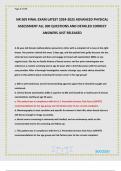Exam (elaborations)
NR 509 FINAL EXAM LATEST ADVANCED PHYSICAL ASSESSMENT ALL 300 QUESTIONS AND DETAILED CORRECT ANSWERS JUST RELEASED
- Course
- Institution
NR 509 FINAL EXAM LATEST ADVANCED PHYSICAL ASSESSMENT ALL 300 QUESTIONS AND DETAILED CORRECT ANSWERS JUST RELEASED
[Show more]



